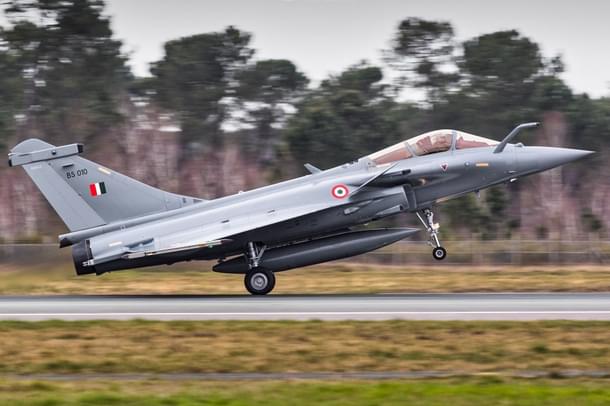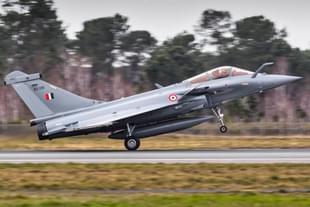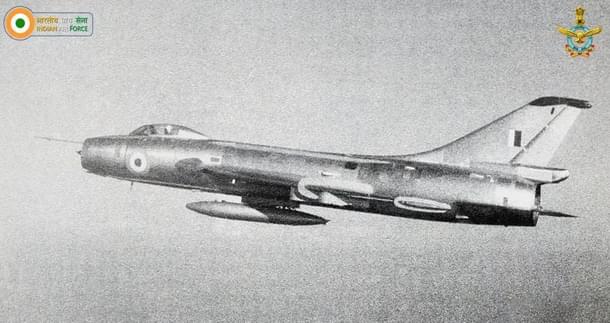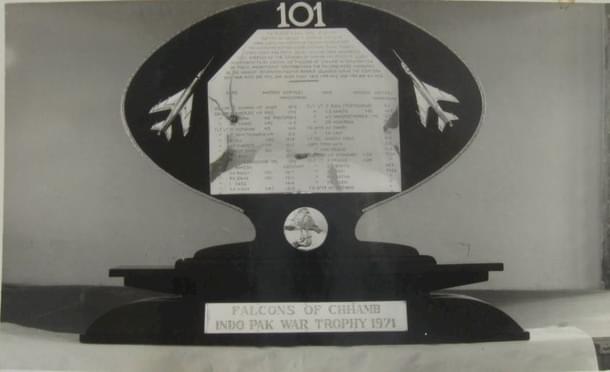Defence
‘Falcons Of Chhamb’ To Get Rafales: History Of IAF’s 101 Squadron Which Will Be Resurrected At Hasimara Air Base
Swarajya Staff
May 17, 2021, 12:04 PM | Updated 02:25 PM IST
Save & read from anywhere!
Bookmark stories for easy access on any device or the Swarajya app.


Number 101 Squadron of the Indian Air Force (IAF) is all set to be revived at the Hasimara Air Force Station in West Bengal this month.
Nearly a decade after it was number-plated, the Falcons will be resurrected with a new batch of four Rafale fighters, which will arrive later this month.
The squadron, formed at the Palam Air Force Station in Delhi in 1949 for the role of photo reconnaissance, was equipped with Harvards and Spitfires.
In 1957, the squadron received British-origin Vampire aircraft, was shifted to the Adampur Air Force Station in the Kashmir Valley. A decade later, in July 1968, it entered the supersonic ear with Su-7s bought from the Soviet Union.
Still based at Adampur in 1971, the 101 Squadron of the IAF participated in operations in the 1971 war in the western sector, flying ground attack and air support missions. The Su-7 fighters of the squadron flew 210 sorties during the war, hitting Pakistani airfields, ammunition dumps and supply trains.

The squadron played a critical role in the defence of the Chhamb-Akhnoor sector, where Pakistan had launched an all-out armour-and-infantry assault to cut off the Indian Army’s access to Kashmir.
Flying from the Adampur Air Base, Sukhoi Su-7 fighters bombed and strafed heavy concentrations of Pakistani troops and armour in Chhamb.
Pilots of the squadron carried out passes over Pakistani troop and tanks, hitting them in dense anti-aircraft gunfire and small arms environment, repeatedly returning to the fray in the face of extremely heavy ground fire.
According to an account by Group Captain Harjinder Kumar Bajaj (Retd), who was a young Pilot Officer working as a Forward Air Controller in Udhampur in 1971, “sixty nine tanks, twenty heavy guns and fifty seven vehicles were destroyed” by the Falcons in Chhamb, bringing Pakistan’s armoured assault to a grinding halt.
It is in recognition of this impressive feat that the Number 101 Squadron of the IAF has since been called the ‘Falcons of Chhamb’.
The squadron was decorated with one Maha Vir Chakra, one Ati Vishisht Seva Medal, eight Vir Chakra, one Vishisht Seva Medal and six Vayu Sene Medals, among other recognitions, for its service in the 1971 war.

Flight Lieutenant Jagdish Bhattacharya, a pilot of the squadron, was hit by ground fire during a mission and ejected over Pakistani territory. Pakistan sent soldiers to capture Bhattacharya, who had suffered spine injury, but he managed to evaded the enemy. He was awarded Vayu Sena Medal for gallantry.
Squadron Leader Madhavendra Banerji, who led at least 14 missions just in the first week of the 1971 war, mostly targeting Pakistani troops and tank formations in the Chhamb-Jaurian sector, was awarded Mahavir Chakra.
“During these missions, Squadron Leader Banerji destroyed two enemy tanks and two guns. On these occasions, Squadron Leader Banerji was personally responsible for attacking the enemy in the face of heavy ground fire, thus relieving pressure on our own troops,” reads the citation of Mahavir Chakra awarded to Banerji, who retired from the IAF in 1990 as Air Vice Marshal.
Over 75 per cent of the sorties flown by the 101 Squadron during the 1971 war were in the Chhamb sector and Banerji led most of these formations.
“Indian Air Force with Sukhois from Falcon (101) Squadron and Hunters from Lightning (20) Squadron, loaded with 500 kg/1000 pounder bombs, 64x57 mm Rockets/68mm SNEB Rocket Pods with 19 rockets in each pod and 30mm guns caused massive destruction and thus played a decisive role in not only blunting the thrust but also forced the enemy to retreat from East of Manawar Tawi,” Group Captain Bajaj writes in his account of the war.
In 1981, the squadron was equipped with MiG-21s and moved to Sirsa Air Force Station in Haryana. Two decades later, in 2002, the squadron was moved back to the Adampur Air Force Station, where it remained till 2011, when the squadron’s Soviet-era MiG 21 were retired from service and it was number-plated.
After over five decades of service under the Western Air Command before being number-plated, the squadron will resume service under the Eastern Air Command headquartered in Shillong, and will deal with the threat from the People’s Liberation Army Air Force, which is ramping up its presence in Tibet.





